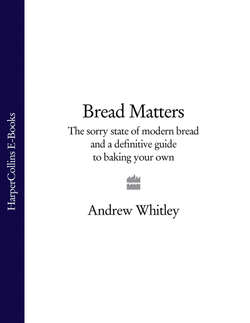Читать книгу Bread Matters: The sorry state of modern bread and a definitive guide to baking your own - Andrew Whitley - Страница 24
Who decides?
ОглавлениеThe baking industry argues that it is embracing the ‘health agenda’ with new, more nutritious products and that a wide choice of breads is now available to everyone. But to make real choices, you have to have enough information and you need to know how to evaluate it. The ingredients list is where you look if you want to know exactly what is in a product. Even if you understand all the terms used on a bread label, you may still be in the dark – for instance, if added enzymes were used to make the bread but are not declared on the label, with details of their origin and effect. By not stating in clear and simple language how their product is made, industrial bakers make it difficult for ordinary people to judge whether their bread is good to eat.
The basis of choice is effectively controlled by the industry. And, in the tart estimate of academic nutritionist Professor Marion Nestle, ‘nutrition becomes a factor in corporate thinking only when it can help sell food’ (Food Politics: How the Food Industry Influences Nutrition and Health, University of California Press, 2003). There is a long history of industry reluctance to make good the deficiencies of white bread. The millers and bakers fought tooth and nail against the scientific consensus in the 1930s that roller milling had removed so many nutrients from flour that many people, especially the poor, were subsisting on considerably less than was physiologically required. Then, as now, they sidestepped the lamentable quality of their basic product and agreed to ‘fortify’ white flour with a small number of minerals and vitamins derived from synthetic sources.
Fortification has now become ‘nutrification’ – an approach to food described by one apologist as ‘the most rapidly applied, the most flexible, and the most socially acceptable intervention method of changing the intake of nutrients without a vast educational effort and without changing the current food patterns of a given population’. Industry, having fought against it, now loves it because it leaves the structure and direction of food processing untouched. Any new nutritional problems can be solved by recourse to its increasingly sophisticated chemistry set and a whole new commercial opportunity has emerged to ‘add value’ by creating ‘functional foods’.
Adding relatively large amounts of synthetic nutrients to basic foodstuffs is scientifically primitive because it must assume that everyone will eat roughly the same amount of fortified food to ensure the right nutrient intake across the whole population. But what if some people already consume a diet naturally rich in nutrients? Are they to be warned off these new foods in case they unwittingly overdose on something?
There is, in fact, a real risk of over-consumption of individual micronutrients. Marion Nestle estimates that industry-initiated additions of iron to the food supply may well be contributing to haemochromatosis (caused by too much iron), which affects at least a million adult Americans. In the case of folic acid, fortification of all flour (as is done in the USA) can lead to a problem, especially with elderly people, in which excessive intake of folate complicates the diagnosis of vitamin B12 deficiency. Too much added calcium is implicated in prostate cancer1 and a recent study links high intake of both iron and calcium with lung cancer2.
The mandatory addition of folic acid to flour has so far been rejected in the UK, but the government’s Scientific Advisory Committee on Nutrition now wants to see it implemented. The millers are happy to oblige, so long as the government picks up the tab. So we are faced with the unedifying spectacle of a milling industry that removes more than half the folate from wheat asking to be paid to put it back again in synthetic form. Nice work if you can get it.
The baking industry is keen on the principle of nutrification because it opens up rich new seams of product development and added value. Breads are now appearing enriched with extra calcium and iron, oestrogen from soya, omega-3 essential fatty acids from linseed and extra fibre from oats, peas or more exotic sources. Such additional ingredients may be of benefit to some consumers but they constitute only a fraction of the nutrients essential to human health, which can be readily obtained from whole grains, fruits and vegetables. And in any case, I cannot help thinking that the baking industry’s historical, and continuing, investment in low-cost white bread makes it an unconvincing advocate of dietary improvement.
As science has confirmed the dietary importance of whole grains, the baking industry has sought ever more ingenious ways to engineer their benefits into breads that have the same bland flavour and ease of production as standard white bread, though with a healthier margin of profit. A charitable observer might regard this as ‘doing good by stealth’, and there can be no denying that any replacement of missing nutrients is good. It is good, particularly, because by focusing on health, however partially, it acknowledges that your choice of bread does matter.
However, any such positive message is undermined in several ways. The industry is still reluctant to state clearly and unambiguously what goes into standard white bread and the extent to which it is nutritionally inferior to less processed alternatives. The strategy of nutrification takes power away from the consumer: the miller, baker or additive formulator controls the quantity and mix of extra nutrients in a loaf – with the result that people whose consumption patterns deviate from the average may end up with an inappropriate intake.
But all this tinkering with added ingredients conceals a much more fundamental reason why your choice of bread matters a great deal.
